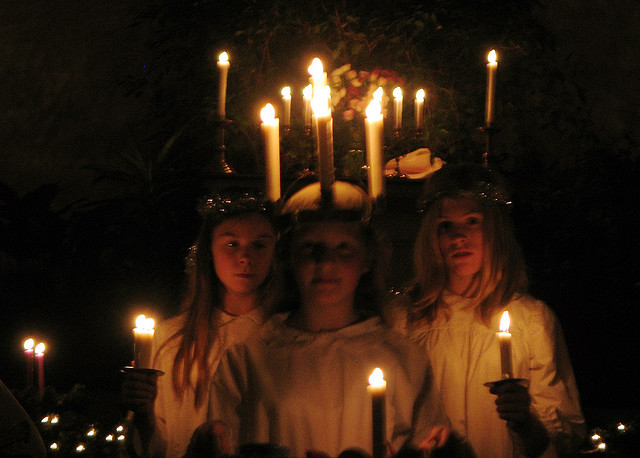10 Tips on Celebrating Cultural Diversity in the Classroom this Winter Season
As the days shorten and the weather turns cold and crisp, families are warming up with their winter holiday celebrations. Candles, lights, sweets and gifts highlight this time of year in many cultures around the world.
Although celebrating specific religious traditions is not permitted in most classrooms in America, there is no reason for teachers to avoid winter holidays all together. In fact, teaching about winter traditions can be a wonderful way to help bilingual children, in particular, feel even more comfortable and included in the classroom setting. The overall focus should be on helping students appreciate both the diversity and similarities of our global traditions.
Here are 10 suggestions for how teachers can help students appreciate winter holidays from around the world:
- Student participation: Give students the opportunity to participate by asking them how they are celebrating this time of year at home with their families. You can use this as a springboard for talking about a shorter list of winter celebrations or you can aim to focus on all of the traditions represented in class by discussing each in more depth.
- Hands-on lessons: When teaching students about different winter holidays, find as many easy hands-on activities as possible – it makes learning even more fun and memorable. Here is an example of a fun lesson plan that incorporates five different countries and celebrations. It isn’t necessary that all activities be done in the classroom. What is important is that students come away with an appreciation for why each activity is meaningful to each culture.
- Get parents involved: Encourage parents to bring in items from their celebrations to share with the class. Parents and/or students can show the class how different items are used and why they are so special and important to the celebration. Traditional clothing and foods can also be brought to highlight a given holiday.
- Read about it: Try to find at least one book to read out loud for each of the celebrations you are covering in class. Best are books that include the holiday from a child’s point of view since it gives students the chance to experience the holiday in a more personal way. For students who celebrate the holiday, ask them how the story compares to their own celebrations at home.
- Connect globally: If you have the resources, see if you can find ways to get your students more directly connected with students from other parts of the world. Contact schools in other countries ahead of time to decide what kinds of exchanges would be possible. Some schools might be able to connect with your class via Skype while others might prefer exchanging hand-made cards or postcards.
- Community involvement: A wonderful way to make our holiday celebrations more meaningful is to get the community involved. This might mean inviting people from the community to your classroom so that they can talk about a given holiday, or it may mean taking students on a field trip to local community events or locations. Reaching out to older members of our community during this cold time of year can also be a wonderful way to get students involved.
- Personal Experiences: It is important that students understand that not everyone celebrates the same holiday the same way. For example, some families may celebrate Christmas by focusing on religious events and traditions, while others may celebrate the holiday in more secular ways. Create opportunities for students to talk about these differences, emphasizing that our individual ways of celebrating is what makes the holiday especially meaningful and unique for each of us.
- Winter Solstice Countdown: Students can have a great time counting down the days together until winter solstice (December 21st). Keep track of the time of the sunrise and sunset each day, noting how the amount of sunlight decreases and the days get shorter and shorter. Students can also keep track of where the sun is on the horizon at a specific time of day each day. Even if students aren’t in school on the winter solstice itself, it is a fun way to help students notice the changes in their natural environment.
- Different Hemispheres: It is possible that students have not yet learned that while it is winter where they live, it is summer where many others live. Use this time of year to help students understand what the northern and southern hemispheres are by using a globe and a flashlight. Talk about what families in the southern hemisphere might be doing right now and how different their celebrations might be where they are living. While we are enjoying sled-rides and hot chocolate, they are sunning themselves on the beach!
- Simple activities: A wonderful way for your class to experience this time of year is with simple activities that are performed in class each day. For example, you might decorate the class with a string of lights, turning them on each morning at the beginning of class. Or for classes with older children, you might light a candle that stays lit during the first lessons. Establishing some simple, general activities like these can make this cold time of year feel just that much warmer in your classroom.
Students are most likely bubbling with excitement about the coming winter break from school and their family’s holiday preparations. Helping students celebrate this time of year as a whole is a wonderful way to bring everyone together.
There are so many overarching similarities between winter holiday traditions: candles, special foods, gifts, spending time with loved ones. Emphasizing these similarities while also highlighting the differences can help students appreciate the diversity that our global cultures bring to our lives during this cold time of year.
Photo credit: EandJsFilmCrew
Which winter holidays will you be teaching your students this year?

No comments:
Post a Comment